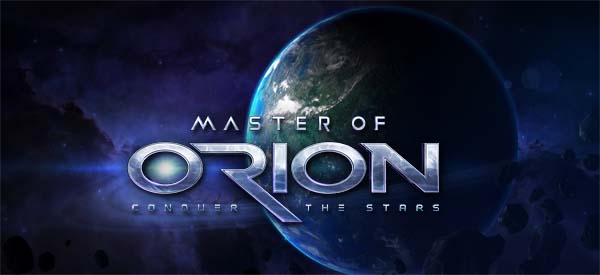
The 2016 reboot of Master of Orion kind of shoots itself in the foot a bit with its own subtitle: "Conquer the Stars". When I play 4x games, I like to feel like I'm really building an empire, managing an economy, and conducting diplomacy. All of those things are present in Master of Orion, but I've gotten a pretty distinct feeling that this is yet another strategy game that falls victim to military rushing being the optimal strategy by far. Master of Orion doesn't really want you to build a civilization and colonize the galaxy; it firmly wants you to do what its subtitle tells you: conquer the stars.
Master of Orion III was kind of shit (it was boring, ugly, and completely lacked personality and substance), but at least it made some effort to be new and interesting. Most noticeably, the galactic map was actually three-dimensional. Sure, this was a navigational and UI nightmare for the human player, but it required players to think differently about how they approached expansion and warfare. At a more fundamental level, MoO3 sought to be a game about macro-management, asking the player to manage a vast galactic empire rather than just a collection of a dozen or so planets. The meat of the game, thus, was intended to be in the mid-to-late stages, as developed empires engaged in epic battles for survival, rather than all the fun and challenge being front-loaded in the early rush to colonize all the nearby planets. It didn't work, but at least it was trying to genuinely innovate the 4x genre.
The new Master of Orion isn't anywhere near that ambitious, and seeks instead to simply bring the original Master of Orion concept (in its simplest form) into the age of high-resolution 3-d graphics. It's a scaled-down, bog-standard space-4x game that borrows heavily from Endless Space and Civilization V. But it is at least a competent one!
Conquer the Stars isn't as big, complex, or ambitious as Master of Orion 3, but at least it's competent.
The galaxy itself isn't very big this time around. Depending on the map's size, there's only a few dozen stars, and most of them only have two or three planets. Unstable star lanes and space monsters can lock you out of exploring certain systems until you research certain technologies or grow your military sufficiently large (respectively). Other than that, exploration is over fairly quickly (especially once you start performing map trades in diplomacy).
Planet-management is also fairly easy. You can assign population meeples between one of three different types of output: food, production, and research. Meeples of different jobs and races have different icons, and unhappy meeples on strike have icons that sit down holding a picket sign. It makes it very easy to see what your population's current status is at a glance. There's just not really much to do with them. You don't have to assign them to work specific buildings, and with only 3 outputs to manage, balancing or specializing isn't that difficult.
All the buildings in the game are also one-time builds that don't serve much function other than to provide flat points of one of the three outputs, or to modify the efficiency of meeples in a particular output category. Buildings that have unique functionality (such as the Spy Center, Gravity Generators, or Interplanetary Administration) are few and far between. The only other thing that you do with your planets is to occasionally terraform them in order to boost your max population and unlock additional slots along each of the output tracks.
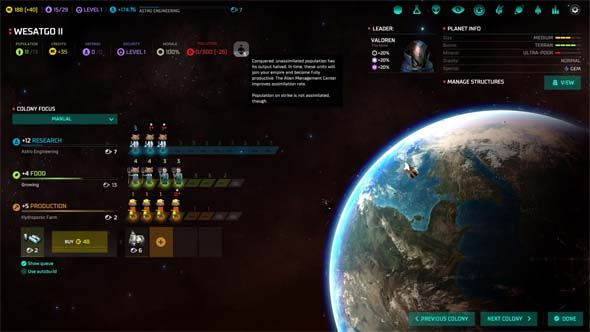
Each point of population is of a specific race, which affects the morale of conquered planets.
The tech tree also feels kind of bland and linear. I would much prefer a tech web along the lines of Civilization: Beyond Earth. Master of Orion kind of goes in this direction a bit by including some techs in which you have to chose which of two different items you want to take when you research certain techs. You can then trade for the other via diplomacy if you want to. It's kind of like the leaf nodes in Beyond Earth, but only some techs have them, and I rarely had to think too hard about which one I wanted... [More]
b529f082-d6e2-4759-8316-2633e3e77143|0|.0
Tags:Master of Orion, Master of Orion: Conquer the Stars, NGD Studios, Wargaming Labs, Steam, strategy, grand strategy, 4x, turn-based strategy, PC, science fiction, space, exploration, expansion, exploitation, extermination, colony, war, Michael Dorn, John de Lancie, Mark Hamill, Alan Tudyk, Nolan North, meeple, Master of Orion 3
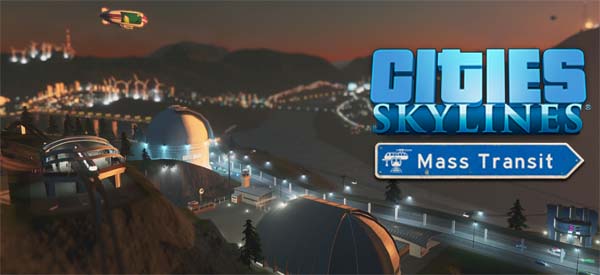
Cities: Skylines is easily my favorite city-builder of the past decade, but its expansions so far have been kind of lackluster. A big part of this is the fact that each expansion (so far) has had a pretty limited scope, meaning that I could really only recommend them if the expansion's particular theming was something that interested you.
While Mass Transit definitely has similarly tight theming, the effects of that theme are felt at a much broader level. Since Mass Transit seeks to specifically expand your transportation network (and fix some problems with creating transportation networks), and since every city of any size has a transportation network, this expansion has much more universal utility than any of the previous expansions.
Red light; green light
In fact, you'll likely start to see the impact of Mass Transit's new systems immediately upon loading up a city -- whether it's a new city or one of your established metropolises. If you're like me, then you'll immediately be thrilled to see that you can now name your streets. That's a cosmetic feature, but your budding young city will also soon encounter the new road and junction-management mechanics. You now have control over each and every intersection, and can assign STOP signs and traffic lights as you see fit.
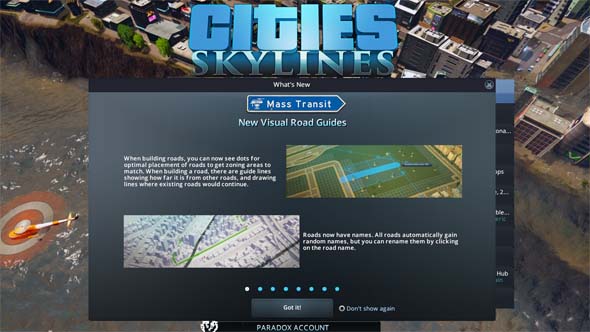
As soon as I booted up the expansion, it informed me that it included a feature from my wishlist
Creating a main thoroughfare and want to make sure that traffic flows steadily through it? Assign it as a "priority road", which puts two-way stops on each road that intersects the thoroughfare, allowing traffic on the thoroughfare to move unobstructed.
Have a three-way (T) intersection? You can even assign only the "trunk" of the T to have a STOP sign, forcing traffic from that road to have to yield to traffic in the crossing road. Unfortunately, you can't add a median with a through lane.
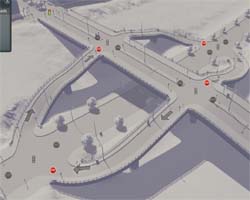
You can force traffic to yield to major streets.
Even the tiniest of cities can benefit tremendously from this simple enhancement, and large metropolises can definitely see an improvement in traffic throughput with efficient use of priority roads. However, priority roads are really the only useful functionality of this feature. Since the game doesn't model car accidents (not even at an abstract level), there's kind of no point in creating four-way stops (as opposed to simply leaving the intersection without any stop signs at all).
This feature also usually entail some frustrating micro-management, as having to manually assign traffic lights and STOP signs can be tedious if you get stuck having to do it for every new intersection. There's also consistent issues with named roads not maintaining their names when I extend them, which forces me to have to manually extend the label onto the new road segment.
The much bigger benefit, however, is that managing traffic is made simpler by the addition of some new route overlays. Not only can you see how congested an individual road is, but you can also see which direction is most congested and also where all the traffic is coming from. This is another item from my wishlist. You can use this feature to see the sources of traffic driving on the selected road, and you can also use it on individual businesses and homes to see where the people at the home or business are coming from and going to. You can even click on an individual citizen or vehicle and see the route that it's currently following.
[LEFT] Every intersection caused congestion prior to the expansion. Since Mass Transit,
you can use "priority roads" [MIDDLE] to speed up traffic in major thoroughfares [RIGHT]. [More]
267321ab-66b4-4de7-b6b1-766ccd9080eb|2|5.0
Tags:Cities: Skylines, Cities: Skylines: Mass Transit, Colossal Order Ltd., expansion, city simulation, traffic, intersection, stop sign, traffic light, monorail, ferry, airship, cable car
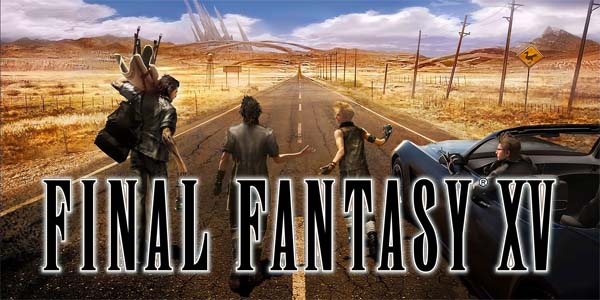
I really don't know what to make of Final Fantasy XV. On the one hand, the game is trying to do something new and kind of interesting with the long-stale open world formula. I desperately want to be able to celebrate the game for these new ideas. That being said, the game just completely blunders so much of its fundamental design, and it tramples on many of these promising new ideas by falling back on too many of the very same tropes that have killed so many other open world games.
The obvious common criticism of the game is that it's got too much of the player just sitting in the car waiting. You don't even have to drive the damned thing, as you can set one of the NPCs in your entourage to do all the driving for you. And even if you do decide to take the wheel, the car drives itself. You just press the gas, and the car automatically steers itself to stay on the road. You can't even turn off of the road even if you want to.
You know what? I'm actually OK with that.
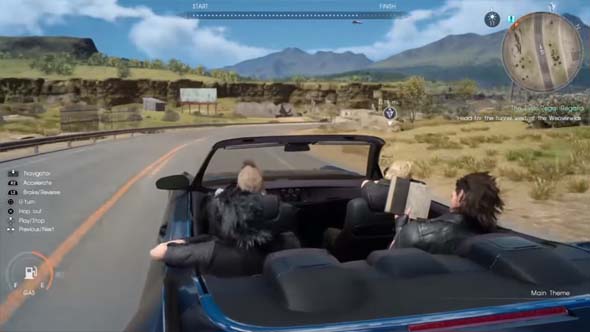
I actually don't mind the long drives, as I can catch up on some reading along with Gladiolus
A nostalgic road trip adventure
You see, having such restrictive travel mechanics actually forces the player to think more about how you're going to navigate the world. While in the car, you are confined to the game's roads and highways. You can't just point the car directly at your objective marker and drive off-road in a straight line to get there. You're also limited to traveling during the daylight hours, and you have to make sure that you budget the time and money to stop for gas and lodgings. There's a genuine amount of logistical planning required for accomplishing virtually any task in this game. You have to think about traversing this world in the same manner that the characters would have to think about it! This is a role-playing game, after all, isn't it? So these travel mechanics are actually pretty clever ways of putting the player in a role-playing mindset and giving you a game to play when you're outside of combat.
I get the feeling that Square-Enix wanted Final Fantasy XV to emulate being on a road trip. You spend large chunks of time sitting in the car driving across the countryside, passing rest stops, scenic overlooks, and roadside diners. You stop every so often to admire the view, take a walk through nature, or chat with the locals. When the sun sets, you are pressured to find a motel to bunk in, or to set up a camp site if you happen to be on foot.
For brief periods of time, this game hits a very serene high in which you start to feel like you're really in this world and with these people, as they sit bored in the car, or eat dinner over a campfire while going over the photos that they took of the day's adventure. It's the same sort of feeling that No Man's Sky hits in its early hours, when you're still awestruck by the sheer size and scope of the new planets you set foot on. Having been someone who used to take annual road trips with my family to visit national parks around the country, seeing a video game try to simulate and systemize that activity (and the human bonding that it engenders) is genuinely endearing and makes me more than a little bit nostalgic.
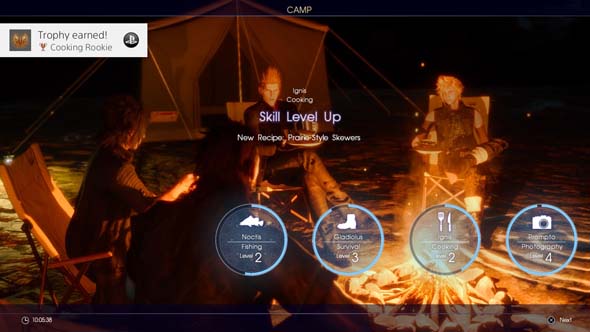
This game makes me nostalgic for the summer camping trips of my youth.
Mundane video game adventure
But then, much like No Man's Sky, Final Fantasy XV shatters that experience by forcing you back into "video game land". It isn't the long stretches of non-interactive driving through a video game vacation that bothers me. Instead, I'm bothered by the sheer tediousness of the mundane fetch quests and busy-work that the game throws at you. You see, a road trip -- and an adventure in general -- only really works if you're always traveling towards a destination. This is a feeling that Final Fantasy X completely nailed!... [More]
8a140761-e4af-4f96-967f-0ee072bf1484|1|5.0
Tags:Final Fantasy, Final Fantasy XV, Square-Enix, RPG, JRPG, open world, road trip, camping, Regalia, car, driving, chocobo, Noctis, Ignis, Gladiolus, Prompto, recipe
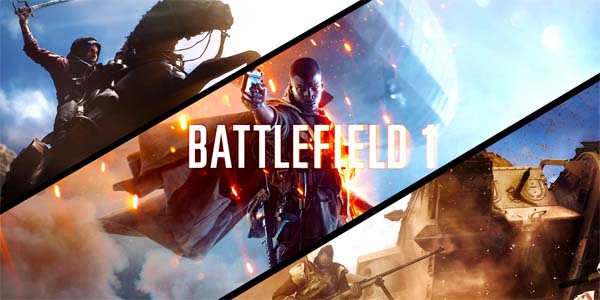
Nobody can make a game about World War I. Trench warfare is too boring. Nothing really happens. There isn't a strong, identifiable villain or good versus evil struggle.
Those are among the many excuses that people made for why all the video games are about World War II, and never about World War I. And then the gaming public and journalists got a glimpse of this:
The teaser trailer for Battlefield 1 was a smash hit.
That teaser trailer was damn good. People were excited. I haven't played a first-person shooter since Call of Duty: World at War, I generally hate online shooters, but even I was excited to try out this game! And other people were hyped about it too.
Now, I never really bought into the idea that World War I was "not video game material". I've long advocated for games to look at all periods of history for inspiration, and World War I is a monumental moment in world history that certainly deserves to be examined by games. The indie market certainly realized this, with games like Valiant Hearts and Verdun. But the big publishers have completely shied away from "The War to End All Wars".
This is a shame. The rapid technological advancements and radically new military tactics that evolved leading up to (and during) the war could be great material to examine in the form of a game. The widescale industrialization of warfare, the complicated politics, and the general fuzziness of the morality of the war are also ripe source material for dramatic storytelling. So it's about time to see this war thrust into the mass market spotlight.
I'd prefer to have seen a strategy game along the lines of Total War; but whatever, I'll give DICE and Battlefield 1 a chance.
UPDATE: 12 MARCH 2018, Better than I gave it credit for:
After having played Activision's Call of Duty: WWII and (especially) EA's Star Wars:
Battlefront II, and having talked about it with friends, I have gained a bit of respect for the successes that Battlefield 1 has been able to accomplish. I've started to like it more in retrospect. Not enough to go back and re-play it or try out any of the expansions (yet), but I do feel that I may have been a bit too harsh on the game in retrospect, especially with regard to its campaign vignettes.
I'm not going to change my original review score, but compared to CoD:WWII and Battlefront II, this game probably deserves a slightly higher grade. So keep that in mind as you read the following review. Of all the big-budget first person shooters that I've played in the past couple years, Battlefield 1
is probably the one that I most enjoyed, and it's the one that I would recommend.
The futile indifference of war
First impressions were actually pretty damned good. I was actually really impressed with Battlefield 1's campaign tutorial. It's basically a guided tour of the game's various core mechanics: shooting at enemy soldiers, capturing victory points, piloting vehicles, and so forth. It does a good job of introducing each of these mechanics and systems by jumping the player around between multiple characters in a large-scale battle.
But what really stuck out to me was how the tutorial transitioned between these different set pieces, and how it handled player death. This tutorial is actually surprisingly merciless and difficult. As you complete one set piece, the game gradually (and subtly) increases the threat until it becomes overwhelming and your character dies (or they just kill you after a timer expires), which allows the game to teleport you to the point of view of another character for the next set piece. The dying character's name and birth / death years are shown on screen during the transition, granting that character with a certain degree of humanization.
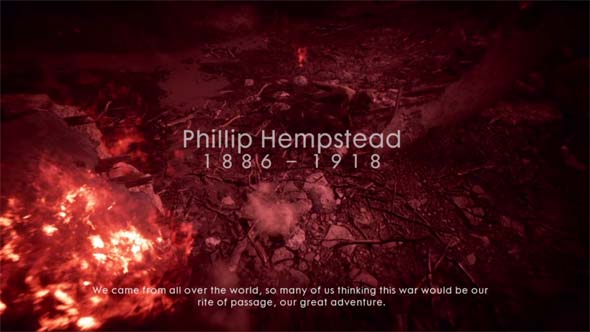
The excellent tutorial emphasizes the indifference and futility of "The War to End All Wars".
Depending on how good you are at the game, you'll go through between half a dozen to a dozen different characters, each with a name and an age. And they all die. The tutorial makes this war look brutal and futile. It even has an almost Dark Souls-like indifference to the player character, killing you without a second thought and forcing you to respawn as another poor, dumb bastard who's about to die for his country, rather than restarting you at a checkpoint until you get it right.
I even wish DICE had gone a bit further by also displaying the character's birth place and maybe even a snippet or two of other biographical trivia. Maybe listing some hobbies, or saying that he was on his high school's varsity football team, or some other little detail like that. DICE settled for just the name and birth / death year, but it's still effective and establishes a very strong running theme throughout the tutorial. The point is a bit undercut by the rapid pacing and by how conventional the actual running and shooting feels. But I still walked out of this tutorial excited by what the rest of the campaign had to offer. [More]
1b3222c5-df25-48fc-8292-199702831456|1|5.0
Tags:Battlefield 1, Battlefield, EA, Electronic Arts, DICE, PC, mouse & keyboard, EA Origin, shooter, online, multiplayer, World War I, war, history, trench warfare, chemical weapon, Harlem Hellfighters, tank, biplane, horse, England, France, Germany, Ottoman Empire, Europe, Argonne Forest, Arabia, Laurence of Arabia, eBay
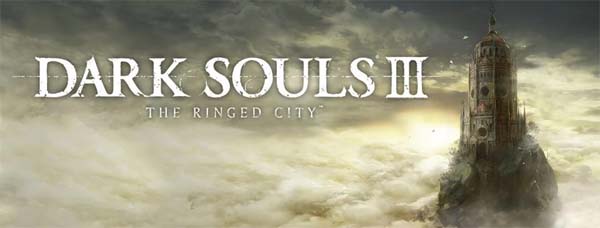
FROM Soft has an erratic track record with how cryptic it can be to find the DLC in the Dark Souls and Bloodborne games. The first Dark Souls required an absolutely arcane process that you'd probably never discover if you didn't already know how to do it. Dark Souls II apparently had its three DLC planned form the beginning, as the vanilla game included shrines for accessing each DLC - at least one of which is in plain view and can't be missed. Bloodborne put a prompt on the screen telling you where to go, but accessing the DLC still required the player to counter-intuitively interact with a specific entity in the game world. And Dark Souls III's first DLC added a character that you could talk to who teleported you to the DLC.
So how would The Ringed City implement its entrance to the DLC? Would it require some arcane process of killing optional enemies in optional areas? Would a dialogue box just pop up to tell the player where to go? If you ask me, The Ringed City might have the laziest and most boring access point of them all. An extra bonfire just appears at one of two specific points, which teleports you to the new area. It makes the whole thing feel like a very detached afterthought.
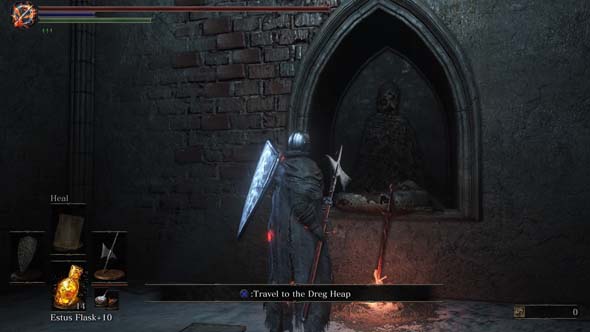
If you don't want to wait till the end of the game, you can access the DLC early by beating Ariandel.
If there's one common thread for the DLC, it's that it always requires the player to be teleported across space and/or time. Continuing that tradition is disappointing. I was really hoping for the DLC to be integrated into the actual game world -- that it would reveal some previously-blocked-off path in some obscure or interesting region of the map that would simply allow the player to walk to the DLC, thus revealing the game world to be much larger than originally believed. Like maybe defeating the Stray Demon gatekeeper above Farron could have opened the gate and revealed a path to the DLC. Or the Kiln of the First Flame could have a new path leading down into the Dreg Heap. Or you could descend into the chasm below the Profaned Capital. Something like that.
Maybe as a fun easter egg for fans, the access point could have been hidden behind a statue sitting behind Andre the Blacksmith in Firelink Shrine. But no, it's just an extra, out-of-place bonfire. Further, the fact that this expansion is an extension of the plot from Ariandel, and the very anti-climactic nature of Ariandel, makes it seem like Ariandel should have been the first act of this expansion, but was separated out into its own expansion for ... whatever reason... [More]
615e23c6-c00b-4bcf-b501-dd94af9350d6|2|3.0
Tags:Dark Souls, Dark Souls III, the Ringed City, DLC, expansion, Earthen Peak, Desert Sorceress, Desert Pyromancer Zoey, Filianore, Darkeater Midir, dragon, Slave Knight Gael, humanity, Dark Soul, Demon's Souls, Old Monk, PvP, Hidetaka Miyazaki
|

| 12 | | | | | | | 60 | | 11 | | | | | | | 55 | | 10 | | | | | | | 50 | | 09 | | | | | | | 45 | | 08 | | | | | | | 40 | | 07 | | | | | | | 35 | | 06 | | | | | | | 30 | | 05 | | | | | | | 25 | | 04 | | | | | | | 20 | | 03 | | | | | | | 15 | | 02 | | | | | | | 10 | | 01 | | | | | | | 05 |
|